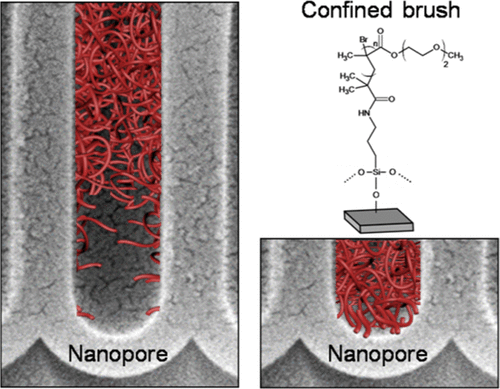Our official English website, www.x-mol.net, welcomes your
feedback! (Note: you will need to create a separate account there.)
Poly(diethylene glycol methylether methacrylate) Brush-Functionalized Anodic Alumina Nanopores: Curvature-Dependent Polymerization Kinetics and Nanopore Filling.
Langmuir ( IF 3.7 ) Pub Date : 2020-02-19 , DOI: 10.1021/acs.langmuir.9b03700 Haider Bayat 1 , Mohammad Raoufi 1 , Imad Zamrik 1 , Holger Schönherr 1
Langmuir ( IF 3.7 ) Pub Date : 2020-02-19 , DOI: 10.1021/acs.langmuir.9b03700 Haider Bayat 1 , Mohammad Raoufi 1 , Imad Zamrik 1 , Holger Schönherr 1
Affiliation

|
We report on the synthesis and characterization of poly(diethylene glycol methylether methacrylate) (PDEGMA) brushes by surface-initiated atom transfer radical polymerization inside ordered cylindrical nanopores of anodic aluminum oxide with different pore radii between 20 and 185 nm. In particular, the dependence of polymerization kinetics and the degree of pore filling on the interfacial curvature were analyzed. On the basis of field emission scanning electron microscopy data and thermal gravimetric analysis (TGA), it was concluded that the polymerization rate was faster at the pore orifice compared to the pore interior and also as compared to the analogous reaction carried out on flat aluminum oxide substrates. The apparent steady-state polymerization rate near the orifice increased with decreasing pore size. Likewise, the overall apparent polymerization rate estimated from TGA data indicated stronger confinement for pores with increased curvature as well as increased mass transport limitations due to the blockage of the pore orifice. Only for pores with a diameter to length ratio of ∼1, PDEGMA brushes were concluded to grow uniformly with constant thickness. However, because of mass transport limitations in longer pores, incomplete pore filling was observed, which leads presumably to a PDEGMA gradient brush. This study contributes to a better understanding of polymer brush-functionalized nanopores and the impact of confinement, in which the control of polymer brush thickness together with grafting density along the nanopores is key for applications of PDEGMA brushes confined inside nanopores.
中文翻译:

聚(二甘醇甲基醚甲基丙烯酸酯)刷功能阳极氧化铝纳米孔:曲率相关的聚合动力学和纳米孔填充。
我们报告了在表面有序的圆柱状纳米氧化铝阳极氧化铝中,通过表面引发的原子转移自由基聚合反应,在20至185 nm之间形成不同的孔半径,从而对聚二甲基乙二醇甲醚甲基丙烯酸甲酯(PDEGMA)刷子进行了合成和表征。特别地,分析了聚合动力学和孔隙填充程度对界面曲率的依赖性。根据场发射扫描电子显微镜数据和热重分析(TGA),得出的结论是,与孔内部相比,孔口处的聚合速率更快,并且与在扁平氧化铝上进行的类似反应相比,聚合速率也更快。基材。孔附近的表观稳态聚合速率随孔径的减小而增加。同样 由TGA数据估计的总表观聚合速率表明,由于孔口的阻塞,曲率增加以及传质限制增加对孔的约束更强。仅对于直径与长径比约为1的孔,可以得出PDEGMA刷子能够以恒定的厚度均匀生长。但是,由于较长孔中的物质传输限制,观察到不完全的孔填充,这大概导致了PDEGMA梯度刷。这项研究有助于更好地理解聚合物刷功能化的纳米孔和限制的影响,其中控制聚合物刷的厚度以及沿纳米孔的接枝密度是限制在纳米孔内的PDEGMA刷应用的关键。
更新日期:2020-03-03
中文翻译:

聚(二甘醇甲基醚甲基丙烯酸酯)刷功能阳极氧化铝纳米孔:曲率相关的聚合动力学和纳米孔填充。
我们报告了在表面有序的圆柱状纳米氧化铝阳极氧化铝中,通过表面引发的原子转移自由基聚合反应,在20至185 nm之间形成不同的孔半径,从而对聚二甲基乙二醇甲醚甲基丙烯酸甲酯(PDEGMA)刷子进行了合成和表征。特别地,分析了聚合动力学和孔隙填充程度对界面曲率的依赖性。根据场发射扫描电子显微镜数据和热重分析(TGA),得出的结论是,与孔内部相比,孔口处的聚合速率更快,并且与在扁平氧化铝上进行的类似反应相比,聚合速率也更快。基材。孔附近的表观稳态聚合速率随孔径的减小而增加。同样 由TGA数据估计的总表观聚合速率表明,由于孔口的阻塞,曲率增加以及传质限制增加对孔的约束更强。仅对于直径与长径比约为1的孔,可以得出PDEGMA刷子能够以恒定的厚度均匀生长。但是,由于较长孔中的物质传输限制,观察到不完全的孔填充,这大概导致了PDEGMA梯度刷。这项研究有助于更好地理解聚合物刷功能化的纳米孔和限制的影响,其中控制聚合物刷的厚度以及沿纳米孔的接枝密度是限制在纳米孔内的PDEGMA刷应用的关键。


















































 京公网安备 11010802027423号
京公网安备 11010802027423号